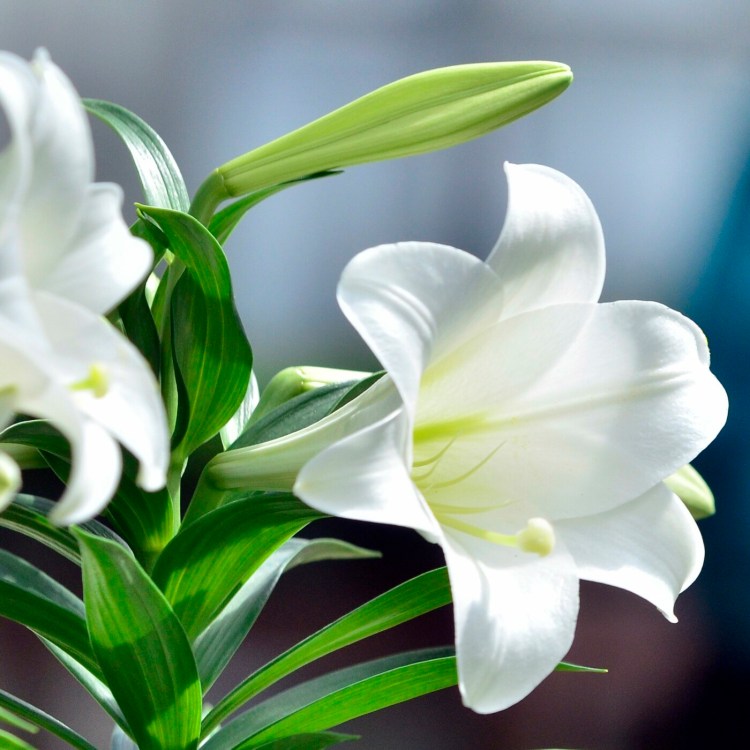The Easter lily that we know today does not exist in nature. It is a real plant, beautiful and a source of enjoyment, but it takes the efforts of many people working a long way from Maine to bring the lush, white blossoms to our homes for today’s celebrations.
The lily mentioned in the Bible probably isn’t even a lily, I learned a decade ago from a lecture at the Portland Flower Show (which I miss greatly now that it’s gone). It was probably related to today’s Clivia, a lovely and fairly expensive plant in its own right, but from a different plant family.
The Easter lily, with the botanical name Lilium longiflorum, is native to islands in southern Japan. According to information on the University of Wisconsin website, starting at the turn of the last century, Japan had a major industry sending the plants to America in time for Easter. The attack on Pearl Harbor ended the trade.
Most of the crop is now grown on the West Coast near the border of California and Oregon. It takes much care and time – as long as four years – before the bulbs are large enough to sell. They are then shipped to greenhouses around the country, where workers bring them into bloom in time for the holiday.
Individual lily blossoms will last just two or three days, but the plant will produce a succession of blooms that altogether lasts about two weeks. What should you do with the plant when the blossoms go by? Plant it outdoors. Most Easter lilies are Zone 5 plants, which covers southern and coastal Maine, although some cultivars are Zone 7. The label isn’t likely to tell you what you have, but plant it outside anyway. If it dies, that’s OK – if you hadn’t planted it, you’d have composted it.
Lilies prefer mostly sunny locations, with well-drained soil, and like – but don’t require – nearby plants to shade their roots. Water regularly. If all goes well, they will bloom the following year in your garden, but in mid-summer, not at Easter.
One note of caution: Around 2004, the lily-leaf beetle arrived in Maine. The bright red pest spread quickly and destroyed many of the plants. The only way to save the lilies was to either to apply pesticides or to spend a lot of time removing the beetles and/or their eggs by hand. At first, we applied pesticides, but later, we mostly stopped growing true lilies, in the Lilium family. Daylilies, by the way, are a different family, Hemerocallis, and not affected, so we continued to grow a lot of those.
Things have gotten better since. The University of Rhode Island led a program creating bio-controls – finding other insects that kill the lily leaf beetles. Released in Maine, some of those biocontrols have shown some effectiveness killing the beetles, according a report the university released last year. We’ve started growing lilies again on our property and haven’t had major damage from lily leaf beetles.
Lilies are not the only flowers that can brighten your home at this time of year. Crocuses and Iris reticulata were blooming outdoors at our house a couple of weeks ago, and daffodils and tulips will bloom soon, too. Garden centers sell those bulb plants in pots, already blooming, as well as some pansies.
Instead of buying blooming bulb plants, many dedicated gardeners will have purchased bulbs some time ago and planted them in pots, keeping them cold for eight weeks either in a garage or the refrigerator, and then bringing them inside for early spring beauty. Use the method for daffodils, tulips and hyacinths – we do a few every year.

Columnist Tom Atwell’s confused amaryllis is blooming in time for Easter, rather than Christmas, as is traditional. He doesn’t mind. Photo by Tom Atwell
Ours have now finished blooming, but in a break from tradition, and, to be frank, an accident, my wife Nancy and I will have an amaryllis, a traditional Christmas flower, in bloom for Easter this year. We bought the bulb in the fall of 2021, planted it in a pot and brought it to bloom that Christmas. As we do with most of our house plants, we put it outside for the summer, then brought it in again when temperatures started to cool. We had hoped for a Christmas blossom a second year running. Well, that didn’t work. The amaryllis took a while to sprout, and only now has produced a long stem – about 3 feet – and a lovely pink blossom.
As a bonus, a second shoot with a healthy-looking flower bud has just poked out of the soil. Not traditional, but fun.
Tom Atwell is a freelance writer gardening in Cape Elizabeth. He can be contacted at: tomatwell@me.com
Send questions/comments to the editors.



Comments are no longer available on this story